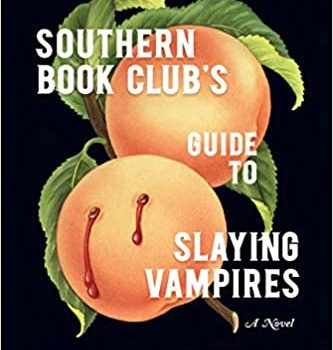Ian Mond Reviews The Southern Book Club’s Guide to Slaying Vampires by Grady Hendrix
 The Southern Book Club’s Guide to Slaying Vampires, Grady Hendrix (Quirk Books 978-1683691433, $22.99, 408pp, hc) April 2020.
The Southern Book Club’s Guide to Slaying Vampires, Grady Hendrix (Quirk Books 978-1683691433, $22.99, 408pp, hc) April 2020.
The year is 1993, and Patricia Campbell, along with her career-driven husband Carter and their two malcontent teenagers Korey and Blue, live in the Old Village, the wealthy section of Mt. Pleasant SC and the backdrop to Grady Hendrix’s latest novel The Southern Book Club’s Guide to Slaying Vampires. Once a month Patricia takes a break from the daily routine (grind) of being a housewife – which includes caring for Mary, Carter’s elderly mother – by attending a book club with fellow wives Kitty, Grace, Slick, and Maryellen. There they bond over a passion for true crime and, particularly, the twisted and depraved minds of serial killers, both factual and fictional. One night, on returning home from the book club, Patricia finds old Mrs. Savage – famous for her award-winning front yards – squatting beside Patricia’s house in a grimy pink nightgown, gnawing on a dead raccoon. In a scene that’s both terrifying and absurd, the old lady attacks Patricia like a rabid dog, tearing off the younger woman’s ear.
After learning that Mrs. Savage died in hospital, Patricia (sporting a mutilated ear) pays her respects to the grand-nephew now residing in the old lady’s home. When no one comes to greet her, Patricia pushes open the unlocked front door and, in direct contravention of the do’s and dont’s of the horror genre, takes a look around. In one of the bedrooms, she finds a man with wrinkled skin, brittle blonde hair and no pulse. In a moment that speaks deeply to her character, Patricia, who was once a nurse, performs CPR. The man leaps into life – more than a little annoyed at the intrusion – and introduces himself as James Harris. This is our vampire, a fact that Hendrix makes no effort to hide. Instead, he quite cheekily takes full advantage of our foreknowledge by having Patricia – ignorant of James’s true nature – invite the bloodsucker into her house.
It doesn’t take long for suave, manipulative James Harris to embed himself into Patricia’s life. At first, she welcomes the interaction, ignoring Mary’s befuddled claims to have a 70-year-old photograph of James, who hasn’t aged a day. It’s only when Mrs. Greene – Mary’s caregiver – asks Patricia for assistance, connecting James to the disappearance and suicide of several black children, that Patricia begins to have doubts. Things come further into focus when she sees for herself what James is capable of. Desperate to protect her kids, Patricia aims to enlist the help of the other wives, but with James now a confidant and financial advisor to all their husbands, it is an uphill battle to convince her book-buddies that a vampire lives amongst them.
What I’ve come to love about Hendrix’s fiction is how he uses horror tropes, whether those are demonic possession, supernatural heavy metal bands, or vampires, to shine a light on political and social issues. My Best Friend’s Exorcism (which is also set in the Old Village) is a satire of the “Satanic Panic” of the late ’80s and a smart critique on class. We Sold Our Souls is a contemporary novel that picks-apart a post-truth, partisan, and social media-driven America. With its focus on the ’90s, The Southern Book Club’s Guide to Slaying Vampires juxtaposes the affluence and wealth of the Old Village, a place “protected from the chaos and the ceaseless change of the outside world” with the neighbourhood of Six Mile, the home for most people of colour, with its potholed roads and “its asphalt edges crumbled off into sand… [with houses] torn up during Hurricane Hugo and rebuilt by carpet-bagging.” And while I’m sure Patricia, Grace, Kitty, Slick, and Maryellen would scoff at the idea that they’re racist, Hendrix provides examples of their racial bias throughout the novel, whether it’s Kitty’s reluctance to travel to Six Mile because it’s not safe or Grace failing to recall the names of Mrs. Greene’s children, despite Mrs. Greene having worked for Grace for several years. Yes, the book club and Mrs. Greene do join forces to confront the vampire in a climax that is as empowering as it is bloody, but it’s telling that James Harris, a metaphor for all that’s wrong with a deregulated free-market – the insatiable greed, the lack of accountability – only gets a toehold within the community because of this social and racial divide.
Hendrix, though, never forgets that, first and foremost, his job is to scare the bejesus out of his readers. He does have a bit of fun along the way; once she witnesses James in action, Patricia purchases every vampire novel in her local bookstore. But, for the most part, The Southern Book Club’s Guide to Slaying Vampires plays it straight. Hendrix’s take on vampires (no spoilers) is an inventive, if gruesome, twist on the mythology, but the star is James Harris, a truly malevolent creation, beguiling and charming (at times he seems so reasonable you forget he feeds off children), but when threatened, utterly ruthless and savage. There is a nerve-wracking scene in an attic involving Harris and Patricia (again, no spoilers) that I won’t be forgetting anytime soon. It’s this ability to terrify, while also having something worthwhile and insightful to say, that makes Grady Hendrix one of my favourite contemporary horror authors.
This review and more like it in the May 2020 issue of Locus.
 While you are here, please take a moment to support Locus with a one-time or recurring donation. We rely on reader donations to keep the magazine and site going, and would like to keep the site paywall free, but WE NEED YOUR FINANCIAL SUPPORT to continue quality coverage of the science fiction and fantasy field.
While you are here, please take a moment to support Locus with a one-time or recurring donation. We rely on reader donations to keep the magazine and site going, and would like to keep the site paywall free, but WE NEED YOUR FINANCIAL SUPPORT to continue quality coverage of the science fiction and fantasy field.






